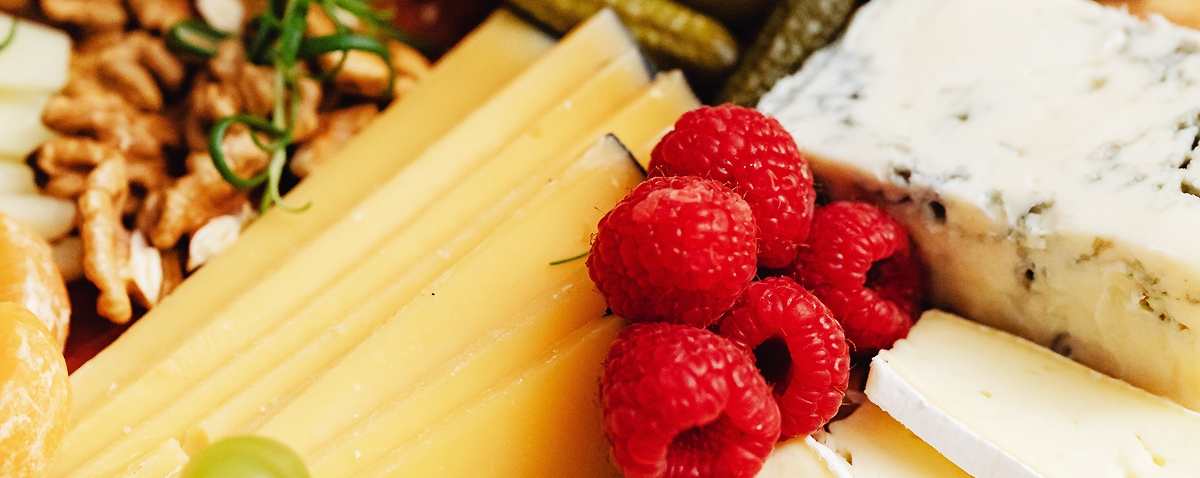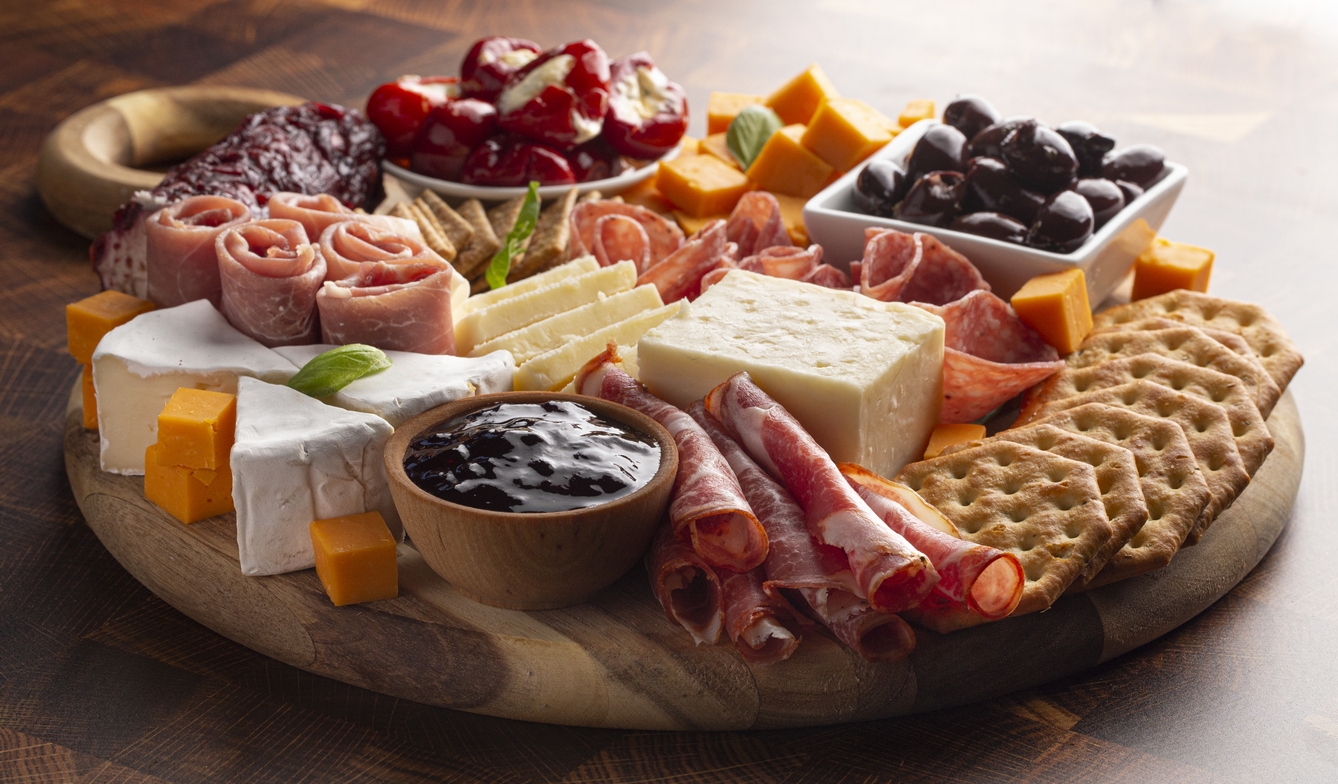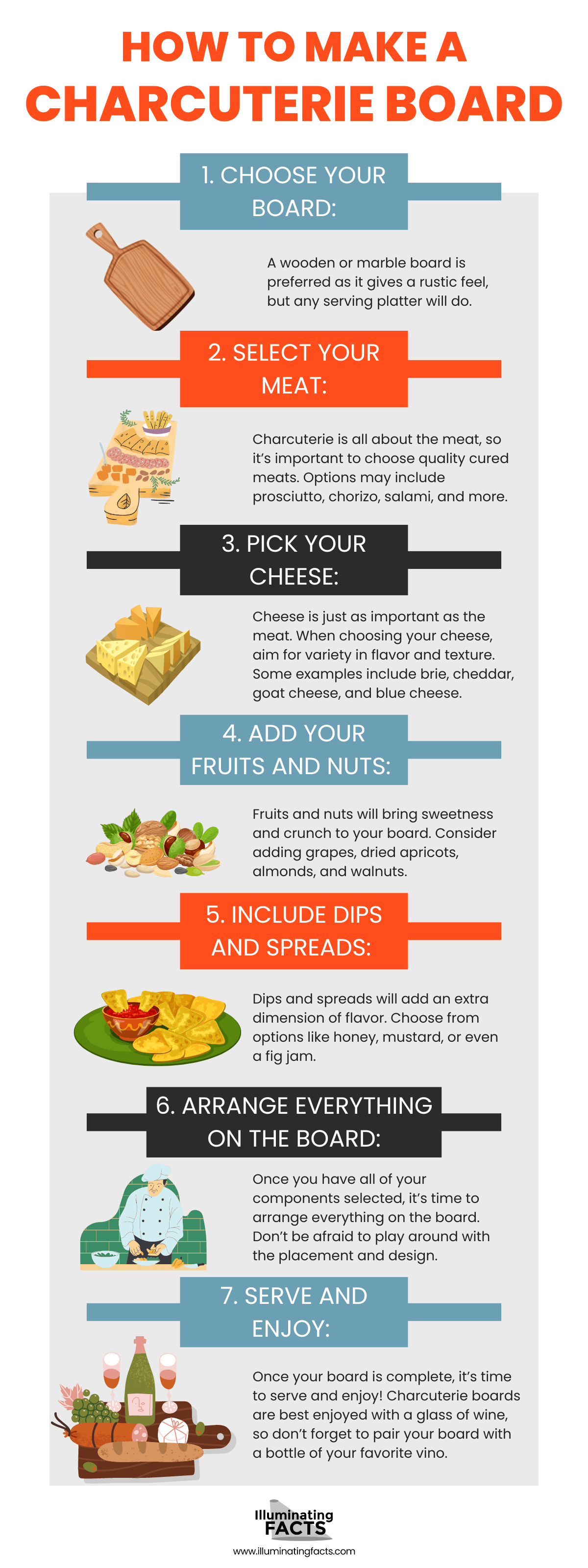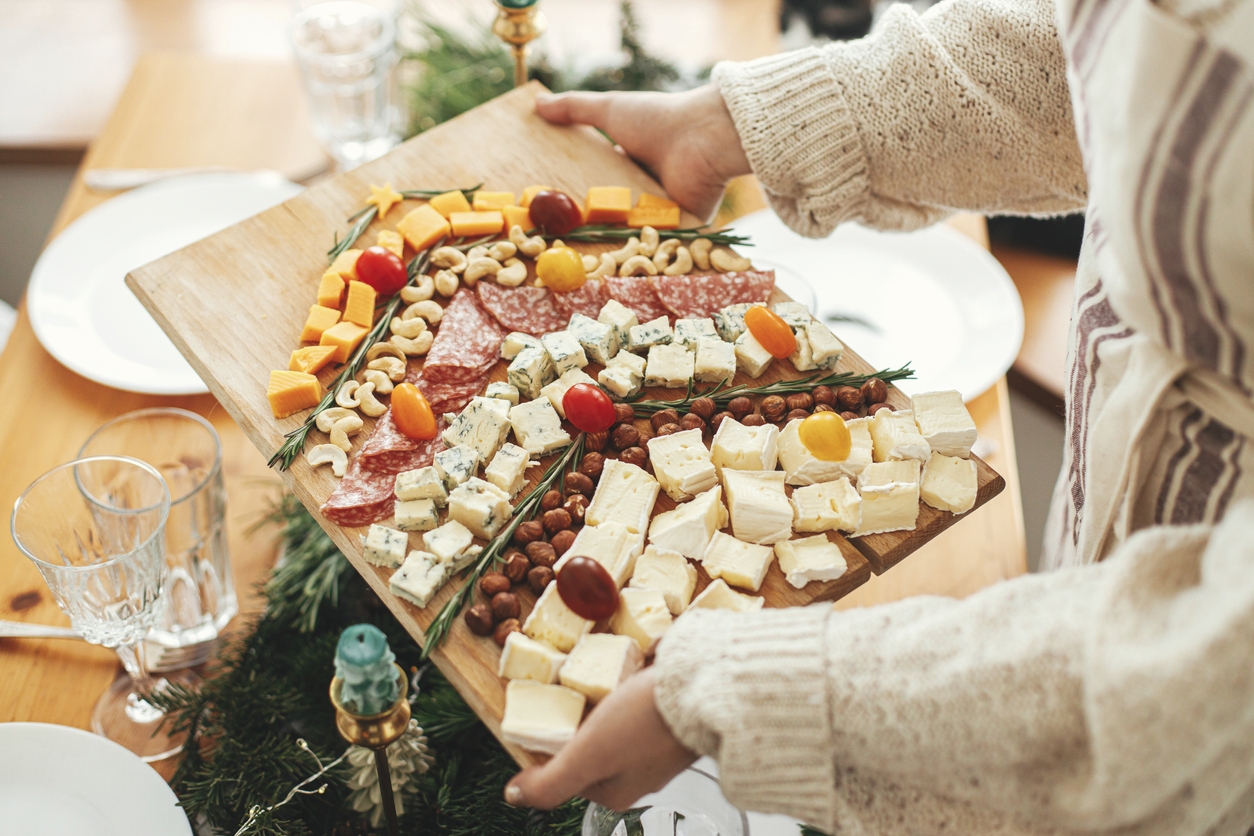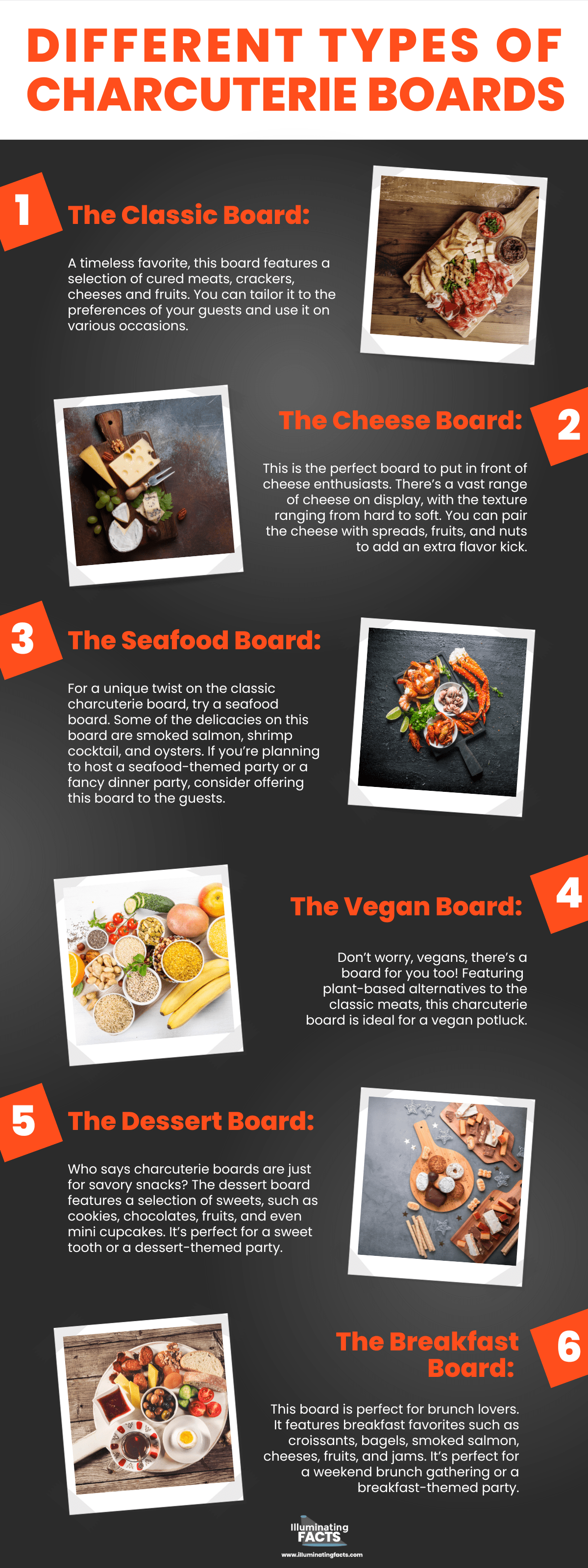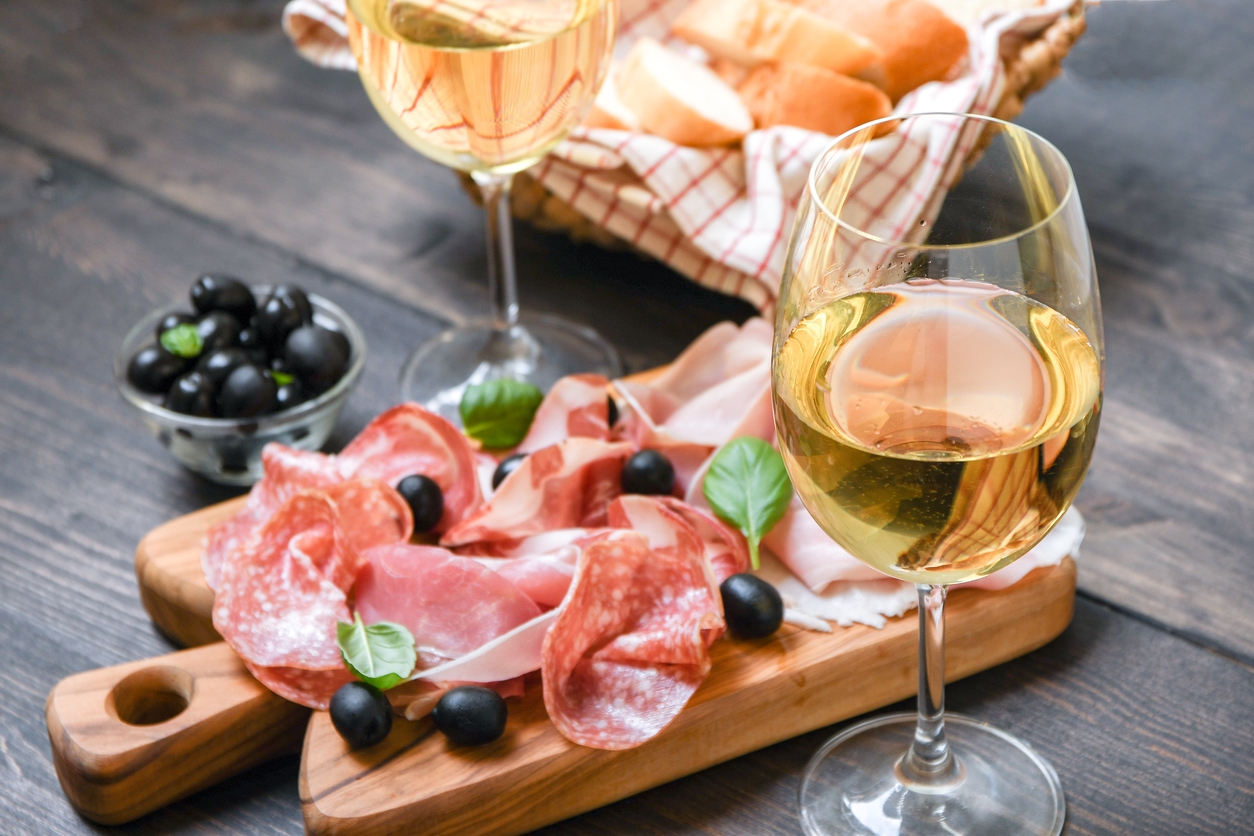Table of Contents
During the holidays, you may attend several parties hosted by friends, coworkers, and clients. And while cuisine varies from traditional to slightly more exotic, there is one “dish” that will almost always be served up—the charcuterie board.
Charcuterie boards have become a popular addition to social gatherings, as they offer a versatile and customizable option for feeding a crowd. But what is the history behind this delicious spread? And how did it evolve to become a regular aperitive at family meetups and events?
From its origins as a way to preserve meat to its modern-day status as a trendy appetizer, we’ll explore the evolution of the charcuterie board. We’ll also cover best practices for making your own board, including types of charcuterie and drink pairings. So buckle up and join us on the journey through the world of cured meats and cheeses.
What is charcuterie and how do you pronounce it?
Charcuterie is a fancy word for a selection of cured meats (salamis, prosciuttos, etc.) paired with other complementary foods (cheese, crackers, fruit etc.). These things are seriously impressive. Imagine a beautifully laid out wooden board covered in all these delicious goodies. It’s the ultimate grazing plate for any foodie, and perfect for when you’re entertaining guests.
One of the best things about Charcuterie is that you can customize it according to the occasion or your preferences. For instance, for a movie night with friends, you might pair some classic cured meats like pepperoni or choriz with some simple crackers and dips to create a casual spread. By nature, this food allows you to use flavors, textures, and colors to create something unique and delicious.
And as far as the pronunciation goes, it’s shar-KOO-tuh-ree. You can think of it like you’re sharing some cool treats with your friends on a board and you’re feeling pretty relaxed about it. See? Easy as pie.
History of Charcuterie
Charcuterie has a fascinating history that goes back centuries, tracing its roots to ancient times. The term “charcuterie” comes from the French words “chair” (flesh) and “cuit” (cooked), and it refers to shops that specialized in preparing and selling cured meats. [1] During the Middle Ages, Charcuterie became more popular as a means of preserving meats without refrigeration. Cured meats were a staple of the peasant diet and were often used to add flavor to otherwise bland meals. Charcuterie also became vital for soldiers and travelers who required a reliable source of protein while on the move.
Over time, Charcuterie evolved and became associated with more refined tastes. In the midst of the 15th century, Europe became home to a number of Charcuterie shops that offered a selection of cured meats, sausages, and pâtés. [2] These businesses had a sophisticated, luxury clientele and frequently near urban centers to be near to their ideal customers.
Today, Charcuterie is considered a crowd pleaser. The versatile dish is presented at gatherings such as parties, weddings, and other events. Gradually, Charcuterie is cementing its place as a staple in contemporary dining culture that can be tailored to suit any taste.
The popularity of Charcuterie boards has also increased, with many restaurants and cafes specializing in their creation. [3] Charcuterie boards typically contain cured meats, cheeses, crackers, fruits, and nuts, and are often served with a variety of spreads and dips.
Overall, Charcuterie has a rich and diverse history spanning centuries, from its humble beginnings as a method of preserving meats to its present status as a sophisticated culinary delight. Whether enjoyed on a board or as a standalone dish, Charcuterie continues to be a beloved and timeless addition to any meal.
The Modern Charcuterie Board
The Charcuterie Board has evolved over the years. Once a simple platter of cured meats and cheeses, today’s modern Charcuterie Board is a masterpiece of artful arrangement and creative flavor pairings.
Thanks to the rise of Instagram foodies and the ever-growing appetite for visually stunning dishes, the modern Charcuterie Board has taken on a life of its own. It’s no longer just a dish, but a statement piece that demands attention and admiration.
The key to a successful modern Charcuterie Board is in the details. Every element, from the selection of meats and cheeses to the arrangement of fruits and nuts, must be carefully considered and executed. The board itself is no exception, with many designers creating custom-made boards to complement the aesthetic of the dish.
But appearance isn’t the only thing to be mindful of. The modern Charcuterie Board is also about flavor experimentation. Chefs and home cooks alike are pushing the boundaries of traditional pairings, incorporating unexpected flavors and ingredients into the mix. Think honeycomb with blue cheese, or even chocolate with charcuterie – the possibilities are endless.
One trend that has emerged with the new Charcuterie Board is the focus on sustainability. More and more chefs are sourcing locally grown, organic meats and cheeses, as well as using eco-friendly serving materials such as bamboo or recycled wood.
Overall, the modern Charcuterie Board is a celebration of creativity and flavor. It’s a dish that has evolved with the times and continues to adapt to new trends and tastes. Whether enjoyed at a fancy restaurant or a casual gathering with friends, the Modern Charcuterie Board is sure to impress and delight.
How to Make a Charcuterie Board
Charcuterie boards are the perfect way to entertain guests while showing off your culinary skills. By following a few steps, you can make a visually stunning and appetizing charcuterie board that will leave the guests wanting more. Here’s how to make one from scratch:
1. Choose your board: A wooden or marble board is preferred as it gives a rustic feel, but any serving platter will do.
2. Select your meat: Charcuterie is all about the meat, so it’s important to choose quality cured meats. Options may include prosciutto, chorizo, salami, and more.
3. Pick your cheese: Cheese is just as important as the meat. When choosing your cheese, aim for variety in flavor and texture. Some examples include brie, cheddar, goat cheese, and blue cheese.
4. Add your fruits and nuts: Fruits and nuts will bring sweetness and crunch to your board. Consider adding grapes, dried apricots, almonds, and walnuts.
5. Include dips and spreads: Dips and spreads will add an extra dimension of flavor. Choose from options like honey, mustard, or even a fig jam.
6. Arrange everything on the board: Once you have all of your components selected, it’s time to arrange everything on the board. Don’t be afraid to play around with the placement and design.
7. Serve and enjoy: Once your board is complete, it’s time to serve and enjoy! Charcuterie boards are best enjoyed with a glass of wine, so don’t forget to pair your board with a bottle of your favorite vino.
Different Types of Charcuterie Boards
There are many different charcuterie boards in existence, with its unique flavors and pairings. Here’s a look at some of the most popular ones to give you some ideas:
The Classic Board: A timeless favorite, this board features a selection of cured meats, crackers, cheeses and fruits. You can tailor it to the preferences of your guests and use it on various occasions.
The Cheese Board: This is the perfect board to put in front of cheese enthusiasts. There’s a vast range of cheese on display, with the texture ranging from hard to soft. You can pair the cheese with spreads, fruits, and nuts to add an extra flavor kick.
The Seafood Board: For a unique twist on the classic charcuterie board, try a seafood board. Some of the delicacies on this board are smoked salmon, shrimp cocktail, and oysters. If you’re planning to host a seafood-themed party or a fancy dinner party, consider offering this board to the guests.
The Vegan Board: Don’t worry, vegans, there’s a board for you too! Featuring plant-based alternatives to the classic meats, this charcuterie board is ideal for a vegan potluck.
The Dessert Board: Who says charcuterie boards are just for savory snacks? The dessert board features a selection of sweets, such as cookies, chocolates, fruits, and even mini cupcakes. It’s perfect for a sweet tooth or a dessert-themed party.
The Breakfast Board: This board is perfect for brunch lovers. It features breakfast favorites such as croissants, bagels, smoked salmon, cheeses, fruits, and jams. It’s perfect for a weekend brunch gathering or a breakfast-themed party.
All of these boards are a great way to show some self-care with a fancy snack platter. That being said, the possibilities are endless when it comes to the type of charcuterie board to create for your next gathering.
What Do You Drink with a Charcuterie Board?
When it comes to pairing drinks with a charcuterie board, there are plenty of options to explore beyond the classic water or soda. Wine is a timeless choice that can enhance the flavors of the meats and cheeses you choose. However, choosing the right wine is essential for complementing the different edibles on your board. [4] For instance, a Pinot Noir or Merlot would pair well with mild meats like speck and prosciutto. In contrast, full-bodied wine like a Cabernet Sauvignon or Syrah would be a greater compliment to richer meats like salami.
Want to add a touch of celebration to your charcuterie board? Then Champagne or sparkling wine would be the most suitable choice. With these drinks, you offer guests the option to balance out the salty flavors of the meats and cheeses. Not to mention, these wines work well for creating a festive ambiance.
Another drink option is beer, which is an ideal choice for fans of hoppy IPAs or saisons. The flavors of meats and cheeses will be enhanced with these drinks, and their carbonation will help cleanse the palate between bites.
Of course, there’s no right or wrong way to pair drinks with a charcuterie board. Regardless of the drink options at your disposal, the key is to find a drink that complements and enhances the flavors of the charcuterie on your board. Get creative with your pairings and see what works best with your board. It’s all about experimentation.
Charcuterie around the world
Charcuterie is a fascinating culinary tradition that has been enjoyed around the world for centuries. From Asia to Europe and Africa to South America, this delicious delicacy has a unique consumption pattern in every region.
For instance, Charcuterie has been a staple of French cuisine in Europe for several years. French charcuterie is popular for the use of pork that is prepared in different varieties, including pâtés, sausages, and terrines. [5] Italian charcuterie is also incredibly popular, with cured meats like prosciutto and salami featuring prominently in antipasti platters.
In Asia, nations like China and Japan have distinct varieties of charcuterie. In China, char siu is a type of BBQ pork that is roasted to perfection, while in Japan, you’ll find a variety of cured meats like karasumi (dried mullet roe) and bresaola (cured beef).
South Americans living in Argentina and Brazil also make charcuterie, but it’s a different style than what you’ll find in other countries. Argentinean cuisine is famous for its asado, which features an array of grilled meats including chorizo and morcilla (blood sausage). [6] Meanwhile, Brazilian cuisine is known for its churrasco, which includes a wide range of meats, from pork to beef to chicken.
Finally, in Africa, countries like Morocco and South Africa have their own unique charcuterie traditions. In Morocco, you’ll find preserved meats like bastilla (a chicken pie) and merguez (a spicy sausage). Biltong (a type of dried and cured meat) is a popular snack among locals and tourists in South Africa.
Overall, charcuterie is a diverse and rich culinary tradition that is popular around the world.
Interesting facts
|
Conclusion
The origin of the charcuterie board dates back to ancient times when people used to cure and preserve meats. As time passed, more and more people started using the board to enjoy a variety of meats, cheeses, fruits, and nuts. To recap, here are the key points we’ve discussed:
- The word charcuterie comes from the French words “chair” meaning meat and “cuit” meaning cooked or prepared.
- Charcuterie was originally a way to preserve meat before the advent of refrigeration.
- The modern charcuterie board is typically made up of a variety of cured meats, cheeses, fruits, nuts, and crackers or bread.
- The board can be customized to fit any occasion, taste, or dietary restriction.
- Many types of charcuterie boards exist, including Italian, French, Mediterranean, and vegetarian.
Overall, the charcuterie board is a delicious and versatile way to entertain guests or enjoy a tasty snack. Whether you just want to treat yourself to a fancy snack or arrange a memorable gathering, a charcuterie board is sure to satisfy.
References
1. History of cooking. (2014, January 26). All That Cooking. https://allthatcooking.com/history-of-cooking/
2. The History Of Charcuterie: Ancient To Modern. (n.d.). https://www.grazecraze.com/. https://www.grazecraze.com/posts/the-history-of-charcuterie-ancient-to-modern
3. Williamson, M. (2021, July 19). Creating art on a charcuterie board. Now Habersham. https://nowhabersham.com/creating-art-on-a-charcuterie-board/
4. What wine pairs well with charcuterie? | Wine 101. (n.d.). Wine Insiders. https://wineinsiders.com/wine-101/what-wine-pairs-well-with-charcuterie
5. Charcuterie | Description, food items, types, & uses. (n.d.). Encyclopedia Britannica. https://www.britannica.com/topic/charcuterie
6. Asado, the Argentinian barbecue | San Antonio de Areco. (2018, August 15). Areco Tradición. https://arecotradicion.com/en/noticias/the-asado-the-star-of-argentinian-gastronomy/

